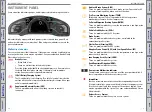
4 |
| 5
ABOUT BATTERY ELECTRIC VEHICLES
ABOUT BATTERY ELECTRIC VEHICLES
ABOUT BATTERY ELECTRIC VEHICLES
n
Battery Characteristics
Instead of using gasoline to power an internal combustion engine, your
vehicle uses stored electricity to power an electric propulsion motor. Your
driving style heavily impacts vehicle efficiency and driving range. Heavy use
of the climate control system can also reduce the vehicle’s range.
There are two types of batteries in this vehicle. A standard 12-volt battery
powers the airbags, interior and exterior lights, and other standard 12-volt
systems; a high-voltage lithium-ion battery powers the propulsion motor and
recharges the 12-volt battery.
Battery electric vehicles have high-voltage components (about 350 V
maximum) such as the EV PCU, High Voltage battery, power control unit,
high-voltage cables (identified by their orange covers), electric motor, and
high-temperature parts such as the radiator. Labels with handling warnings
are attached to these components.
The High Voltage battery gradually discharges when the vehicle is not in
use. If allowed to discharge too much, the battery may become damaged.
If your vehicle is parked for an extended period of time (as when being
stored), periodically recharge the battery to maintain sufficient charge
levels. At least once every three months, turn on the power system and keep
it on for more than 30 minutes to allow the battery to recharge. Excessive
heat can also damage the battery. On hot, sunny days, try to avoid parking
your vehicle under direct sunlight. If the High Voltage battery becomes
fully discharged or damaged and you are unable to start the power system,
consult an authorized Honda Clarity Electric dealer.
n
Temperature
When storing the vehicle, make sure not to expose it to extremely low
temperatures: If the temperature of the High Voltage battery drops to
–22°F (–30°C) or below, the power system may not start. Wait for the High
Voltage battery to warm up, or warm it up by plugging in the vehicle. If the
temperature of the High Voltage battery drops to –31°F (–35°C) or below, the
power system will not start. Wait for the High Voltage battery to warm up or
move the vehicle to a warmer location. Note plugging the vehicle in will not
help in this case.
n
Battery Warming System
Designed to prevent the temperature of the battery from dropping when
outside temperatures drop, thereby maintaining starting and running
efficiency. If the vehicle is plugged in when outside temperatures are low,
the battery warming system will use the power from the charging equipment
to maintain the temperature of the battery until the next time the vehicle is
driven.
If the vehicle is left unplugged in cold temperatures, the temperature of the
battery will drop, possibly resulting in a loss of running efficiency. If left for
an extended period of time in extremely cold temperatures, the vehicle may
not start. We recommend that you plug in your vehicle when you are parking
or storing your vehicle in cold temperatures.
NOTICE
n
Emergency Shutdown System
The emergency-shutdown system may activate when the vehicle is
impacted by some incident such as a crash or collision. When this
system activates, the High Voltage system automatically shuts down and
your vehicle no longer moves. To place the High Voltage system back in
operation, consult an authorized Honda Clarity Electric dealer.





















